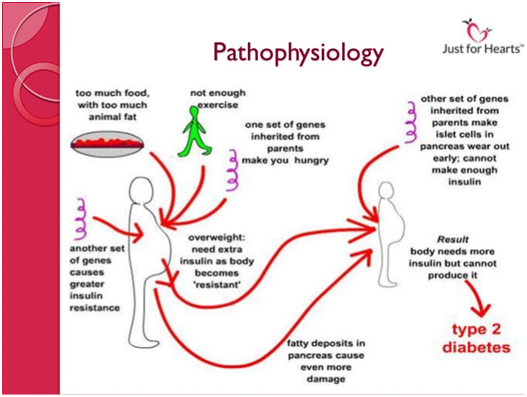
Definition-:Diabetes melietus is a metabolic disorder which is characterized by hyperglycemic condition due to defective functioning of insulin hormone…
It may be due to abnormal secretion of insulin & altered functioning of insulin hormone which secrets by beta cells of pancreas…
Etiology-: according to etiology it divides in 3 types;
• Insulin dependent diabetes melietus
• Non insulin dependent diabetes melietus
• Gestational induced diabetes melietus….
Absolute or relative lack of insulin produce by beta cells resulting in hyper glycemia….
Impaired secretory respons of insulin to rises in glucose & due to this gluneogenesis may occurs..
IDDM:-it may cause due to following reasons-
• Autoimmunity
• Viral infections
• Environmental theories
• Other disease conditions.
• Old age
NIDDM:-It may cause by following reasons-
• Hereditary
• Genetic
• Obesity
• Beta cells defect
GIDM:-It define as glucose intolerance occurring during pregnancy &disappear after delivery…
Clinical menifestations:-there are many sign & symptoms :
1. Hyperglycemia
2. Weight loss
3. Poly urea
4. Poly depsia
5. Poly phagia
6. Blurred vision
7. Altered tissue perfusion
8. Poor wound healing
9. Recurrent infection
10. Skin infection may be appear
11. Dry skin
12. Kitoacidosis
13. Dehydration
Diagnostic evaluations:-many tests are useful for evaluation
• Glucose tolerance test
• Fasting glucose test
• Blood test
• Urine test
• Physical examinations
• History taking
Management;-management of this divided in 3 types;-
1. Medical management
2. Dietary management
3. Exercise
• Medical management: many hypoglycemic agents are given for reduce level of glucose:-
Eg; tolbutamide; metformine; glycazideetc;
• Dietary management;-dietary control with caloric restriction of carbohydrate maintain ideal body weight .
The goal of meal planning is to control blood glucose level& weight reduction is another goal;;
• Exercise:-regular schedule of exercise also helpful in reduction of blood glucose level
Complications:-
1. Diabetes keto acidosis
2. Cerebral vascular disease
3. Retinopathy
4. Neuropathy
5. Peripheral vascular disease
6. Cardiac disorders







